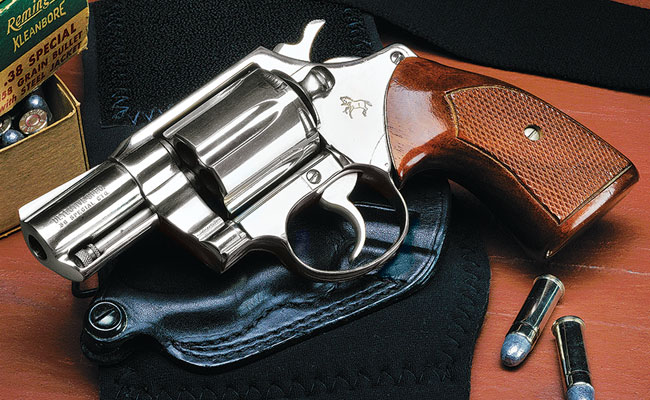
Colt Detective Special
My Detective Special has been with me since I bought it in 1974. It’s an old friend, and I have carried it on many occasions. This six-shot snubnose revolver has been a popular backup gun for law enforcement ever since it was introduced in 1927.
The Detective Special underwent a number of changes through the years. The First Series was produced from 1927 to 1947 and used a narrow frame, shorter ejection rod, a checkered hammer spur and wood grips. The Second Series ran from 1947 to 1972 and included a long ejection rod, a smooth cylinder latch and a serrated trigger spur. Second Series grip panels were plastic at first, later changed to wood in 1955.
My gun is a Third Series (1973 to 1986), and it has a shroud protecting the ejector rod, with the front sight machined out to be a full ramp. Much larger wood grips were now standard, and only a few, like mine, were finished in bright nickel. There was also a three-inch barrel option.
There was a model called the Banker’s Special that was manufactured in 1928 chambered for the .22 Long Rifle and the .38 Colt New Police. I have a particular interest in American railroads, and the Banker’s Special was a popular gun on the hips of the mail clerks who sorted mail on the trains as they sped along from city to city during the war.
There was a Colt Commando Special version with rubber grips and a matte finish produced from 1984 to 1986. There were other variations—such as a double-action-only and an optional bobbed hammer—making it a popular target of collectors.
Despite years of shooting, the action on mine is tight and cylinder rotation is smooth. When you take the gun apart, you can see the extra work that went into it, much like the famous Python. The single action breaks around six pounds with the crispness associated with a pedigreed gun, and the double action, while not as light as the Python, is 10 pounds with only minor stacking.
The “gutter” rear sight has tiny serrations on each side. On a nickel gun they’re basically decoration, but on a blued model they would cut down glare. There are nicely cut serrations across the hammer and the grips. These are small enough not to hinder the gun as a hideout revolver but large enough to take even the stoutest loading with ease.
Six countries worldwide plus the United States used the Detective Special for law-enforcement duties. It was discontinued in 1995, and most in law enforcement as well as civilians have moved on to higher-powered semiautomatics for backup use. Me? I’ll keep my Detective Special, thank you very much.
The post A Classic: Colt Detective Special appeared first on Handguns.

